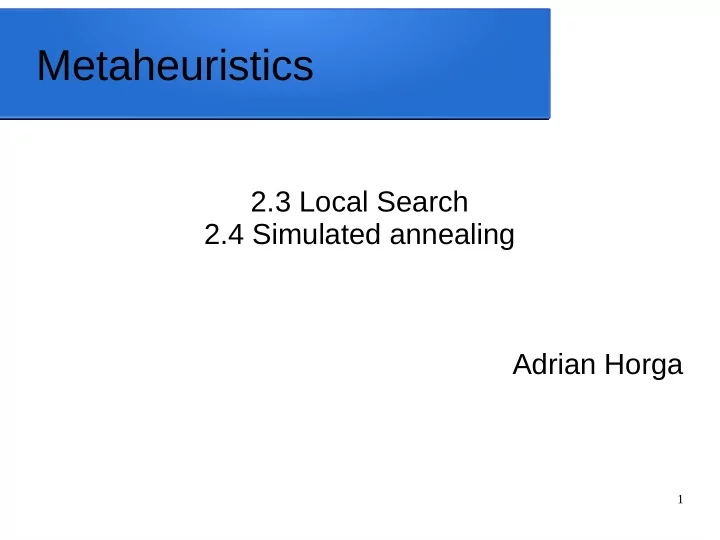

Metaheuristics 2.3 Local Search 2.4 Simulated annealing Adrian Horga 1
2.3 Local Search 2
Local Search ● Other names: – Hill climbing – Descent – Iterative improvement – General S-Metaheuristics ● Old and simple method → at each iteration replace the solution with a neighbor if it improves the objective function 3
Example 4
Another one 5
Properties ● Start with s 0 ● Generate k neighbors ( s 1 ,s 2 , ... ,s k ) ● “k“ is not known a priori s i + 1 ∈ N ( s i ) , ∀ i ∈[ 0, k − 1 ] ● f ( s i + 1 )< f ( s i ) , ∀ i ∈[ 0, k − 1 ] ● ● s k isalocal optimum : f ( s k )⩽ f ( s ) , ∀ s ∈ N ( s k ) 6
Selection of the neighbor – time is money ● Best improvement (steepest descent) – Evaluate every neighbor → pick the best – Time consuming for large neighborhoods ● First improvement – Pick the first that is better – In practice is similar to “best improvement” – Might need to evaluate everything if no better solution is found ● Random selection – Just random 7
Escaping local optima ● Iterating from different solutions – Multistart LS, iterated LS, GRASP ● Accepting non-improving neighbors – Simulated annealing ● Changing the neighborhood – Variable neighborhood search ● Changing the objective function or the input data of the problem – Guided LS, smoothing, noising methods 8
2.4 Simulated annealing 9
Simulated annealing ● Based on statistical mechanics → heat then slowly cool a substance to obtain strong structure ● Low starting temperature/fast cooling → imperfections ● SA is a stochastic algorithm which enables degradation of a solution ● Memoryless 10
Analogy – real life 11
Basic idea ● The acceptance probability function → pick nonimproving neighbors ● The cooling schedule → how the temperature decreases (efficiency or effectiveness) ● The higher the temperature → the higher the chance of picking a “bad” neighbor 12
Move acceptance – or how likely an increase of energy is 13
Cooling schedule ● Initial temperature ● Equilibrium state ● Cooling ● Stopping conditions 14
Initial temperature - start ● Accept all – High starting temperature to accept all neighbors – High computation ● Acceptance deviation – Use a temperature based on preliminary experimentations – Use a standard deviation ● Acceptance ratio – Use an interval for the acceptance rate (e.g. [40%, 50%]) 15
Equilibrium state - finish ● Static – Predetermined number of transitions to equilibrium state ● Adaptive – Characteristics of the search impose the number of generated neighbors – Equilibrium state may not be reached at each temperature 16
Cooling – how do we iterate ● Linear ● Geometric ● Logarithmic ● Very slow decrease – Only one iteration per temperature ● Nonmonotonic – Temperature may increase again ● Adaptive – Dynamic decrease rate – Few iter. at high temp. / Many iter. at low temp. 17
Stopping condition ● Reaching the final temperature – Or ● Achieving a predetermined number of iterations – Or ● Not improving in a while 18
Other similar methods ● Threshold accepting ● Record-to-Record Travel ● Great Deluge Algorithm ● Demon Algorithms 19
Threshold accepting ● Q is the threshold ● Accept only neighbors that are not worse than the threshold ● Ex.: Q may be nonmonotone, or adaptive 20
Record-to-Record Travel ● “Record” is the best objective values of the visited solutions so far ● “D” accepted deviation ● A small deviation → poor results, faster ● A high deviation → better results, slower 21
Great Deluge Algorithm ● Analogy with a climber in a rainstorm → rain level goes “UP”, the climber needs to keep his feet dry ● Pick neighbor based on water “LEVEL” (above/below) ● Update “LEVEL” based on “UP” 22
Demon Algorithms – hard to explain 23
Demon Algorithms - types ● Bounded DA ● Annealed DA – Similar to SA, credit (“D”) is the temperature ● Randomized Bounded DA – Use Gaussian distribution for “D” ● Randomized Annealed DA – Same search as RBDA with annealing from ADA 24
Conclusions ● Local search – Easy to do, local optima ● Simulated annealing – Try to find the best schedule or else you end up doing local search ● Other methods – Simulated annealing with less parameters 25
Recommend
More recommend